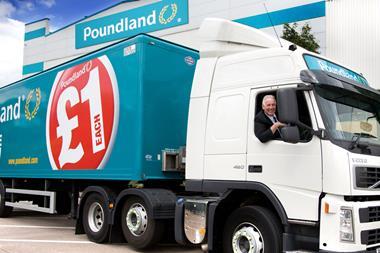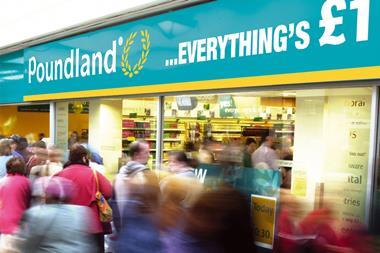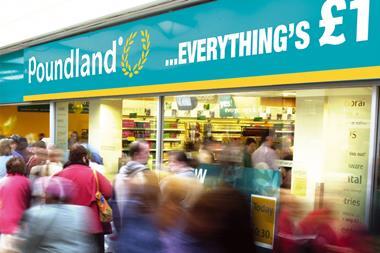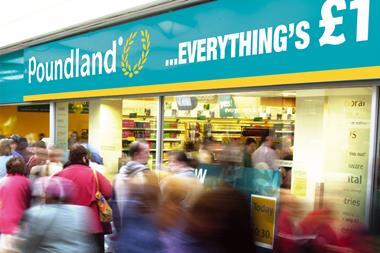99p Stores has been touted for sale since 2011. So it wasn’t entirely unexpected when Poundland announced last Friday its intention to acquire its rival discounter.
But is it just about eliminating a pesky competitor? (On some high streets where the two go head to head, Poundland has been known to sell its products for as lite as 95p.) Or is there more to a deal that will increase Poundland’s estate to more than 800 stores dealing with seven million transactions a week?
That’s what the Competition and Markets Authority is now in the process of deciding. A spokesman for the CMA says once it receives official notification it has 40 days to reach a decision. And the first thing for the CMA to determine is Poundland’s competition.
Speaking exclusively to The Grocer, CEO Jim McCarthy says, as far as he’s concerned, the more the merrier. “We compete with everybody. We operate in 17 different categories. Even if you spilt it down into the discount sector and you put Primark, Lidl, Aldi, TK Maxx, B&M, Home Bargains, Poundstretcher, Poundworld, Wilkinson, the independents and the market traders who set up in towns and cities all over the country every week selling at discounted prices, there is a huge amount of competition already. And our percentage of that subset is quite small.”
It’s a natural stance for Poundland to take. The more competition it has, the less impact its overnight expansion would have on rivals, which would please the CMA. And McCarthy has a valid point. The discount sector has exploded since the credit crunch and the definition of what is and what isn’t a discounter has become increasingly broad.
Yet although there is significant overlap in range at any of the discounters mentioned by McCarthy, they are a different proposition to a pound shop. B&M recently revealed that 18% of its range is priced at 99p or £1, and 28% is priced between £1.01 and £3. But it also sells furniture, vacuum cleaners and TVs for up to £379. That makes it a completely different animal.
Furthermore, if there is any clarity to be had when it comes to bracketing the wide array of discounters, it’s quick and easy to pigeonhole the fixed-price players. “If they define it narrowly as ‘pound shops’ the deal could be at risk,” says David Stoddart, analyst at Edison Investment Research.
The CMA spokesman is circumspect on the conclusions it will ultimately draw but confirms it has already ruled out Lidl, Aldi and Netto from the comparison. As for retailers like B&M he won’t be drawn, beyond saying: “if you consider them to be a competitor in the field then they are likely to be involved [in the initial assessment].”
Once it has been established who will be included, he says the CMA will establish “what their market shares are, then go through our normal procedures to examine whether or not there will be a substantial lessening of competition in the sector.”
Underwhelming
McCarthy is “optimistic the CMA will understand the evidence we have given them” though he could be forgiven for hedging his bets. But on the basis it gets the green light, it won’t materially increase its geographical coverage.
Paul Langston, consulting partner, location strategy at CACI, says Poundland “currently reaches 48% of the UK retail market. By adding the 99p Store estate this figure only grows to 51%.”
That sounds underwhelming. “It does, that’s what makes it interesting,” says Langston. “99p Stores are generally in such small centres, or in centres already in the shadow of an existing Poundland, so Poundland are only incrementally growing 3% of the market. They are relying on getting more out of the towns they are already in. I’m not saying it’s a bad decision to buy it, but it’s not opening up virgin territory.”
That overlap is the only real concern of the Association of Convenience Stores, which fears store closures more than reduced competition in the wake of the acquisition. “Vacant shops are a significant problem for hundreds of town centres,” says ACS chief executive James Lowman. “If acquisitions lead to some units closing, there needs to be new businesses filling those sites.”
McCarthy says it’s not his intention to shut a lot of stores. “It doesn’t necessarily follow that because you’ve got a 99p next to Poundland that we would close one. Each location either has been, or will be assessed and we will continue to do that and make the right decision based on the financial returns.”
As for the Poundland operating model and range, nothing radical is expected to happen. The two stores are quite similar, a riot of health and beauty, entertainment, household, homeware and an increasing amount of grocery, so it’s likely that the wide range of suppliers that serve the discounters will just see increased volumes head for Poundland instead.
Nisa a loser
One exception is Nisa, which teamed up with 99p Stores in November 2013. A spokeswoman says Nisa supplies “99p Stores and other similar discounters a significant range of ambient and chilled products”. However, she also confirmed that it doesn’t supply Poundland, so Nisa will take a hit if the deal goes through.
Perhaps it’s behind the scenes that will see the biggest change. Fixed-price fmcg is a volume business, so more stores should mean more volume and a healthier margin for McCarthy and co, which is maybe why the share price - at 350p before the deal was announced - shot up to 421p afterwards, and has now settled at a perky 388p, after banks like Credit Suisse nodded approvingly at the “extremely attractive economics of this transaction”.
Whatever happens, chess player McCarthy is staying cool. “We’re not dependent on this deal at all,” he says. “We have a very strong organic store opening programme.” And at 60 stores a year, they do. So although there is a degree of uncertainty over this next period of expansion, expand it will. And its rivals won’t always have the CMA to help them out when it does.


















No comments yet